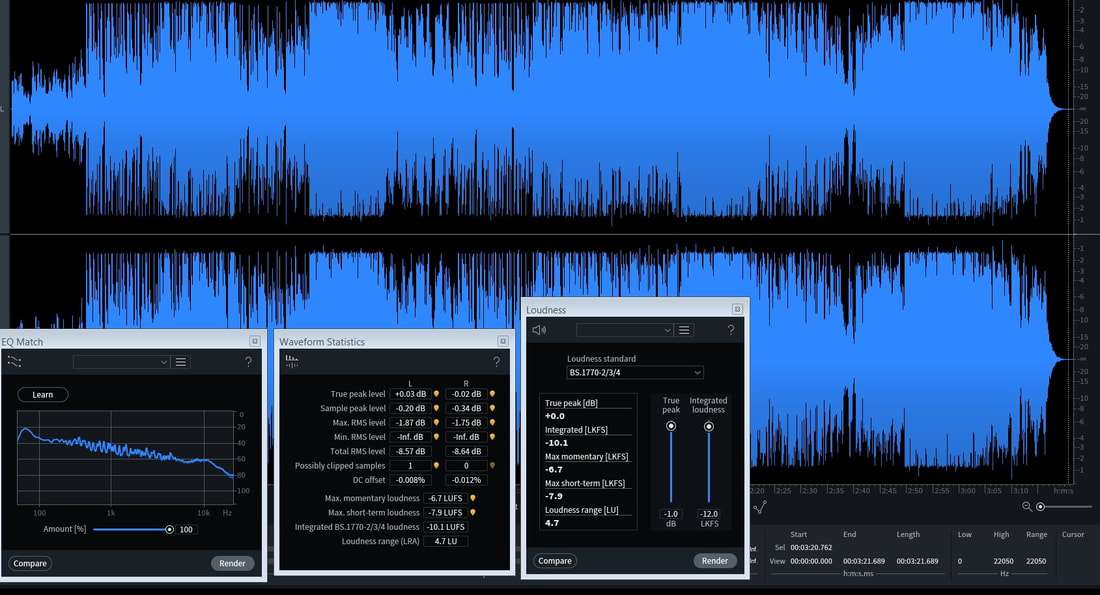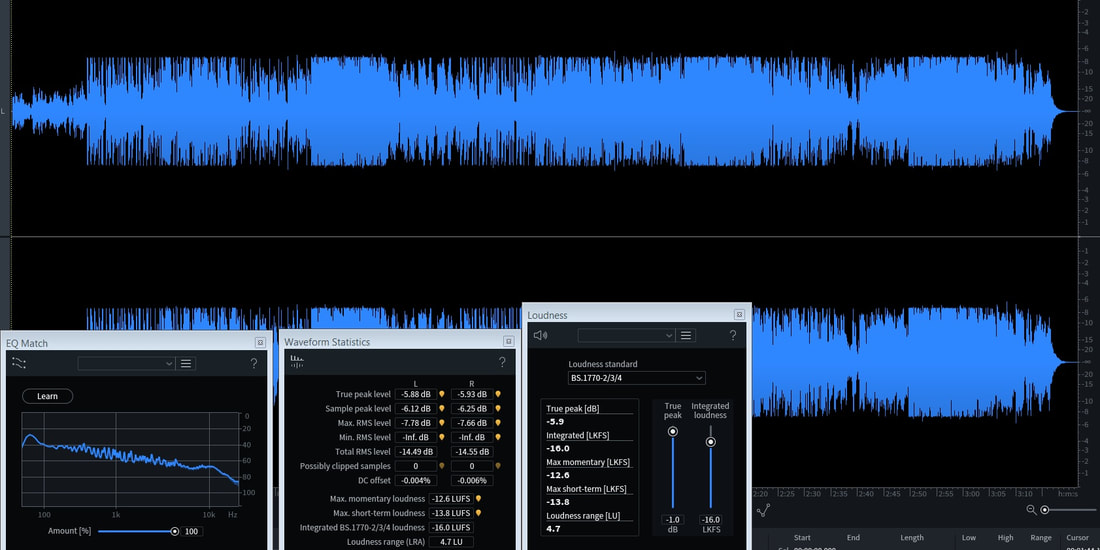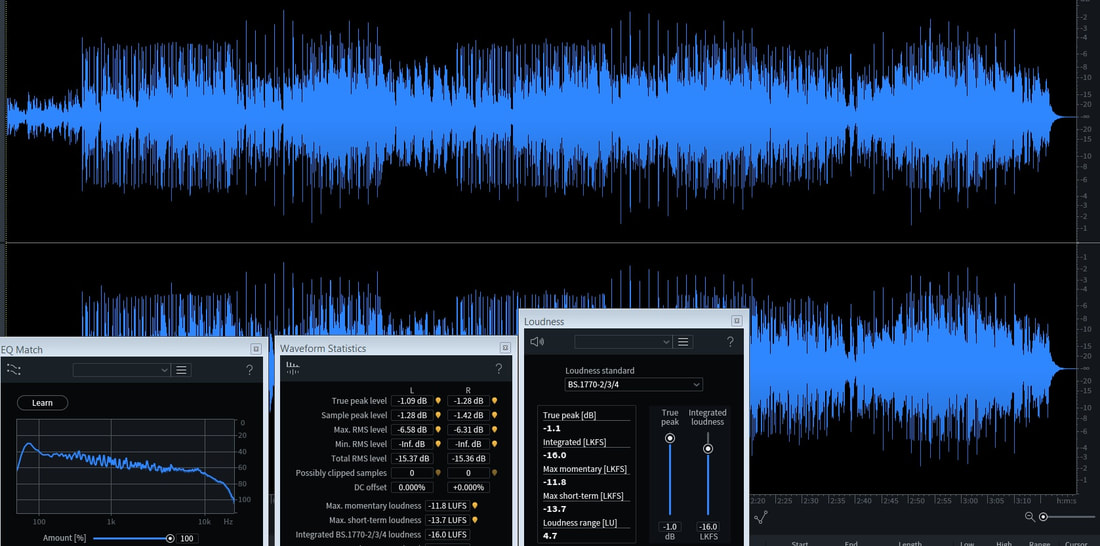LKFS/LUFS -10.1 dB
Clipped Samples Left 1
Clipped Samples Right 0
DC Offset -.008%, -012%
Dynamic Range 4.7 dB
RMS Level Left -8.57 dB
RMS Level Right -8.64 dB
We can guess with considerable accuracy that -11 dB LUFS is halfway to horrible. In any case, this gives you a range to expect over compression just by the LUFS number.
The next problem is the clipped sample issue. If the sample peaks are not carefully and skillfully controlled to a level of -.1 to -1 dB, the result will be sample peaks that are digitally clipped (sawed off) by the digital converter that can not have any signal above 100% or 0 dB. The result of the clipped samples is easily seen in a good waveform analyzer, and the number of clipped samples is easily computed by a program such as Izotope's RX. Since the waveform is what determines the sound that eventually comes out of your speakers or headphones, the clipped samples will absolutely affect the quality of the sound as you hear it. You can go through the many examples on this website and see that virtually all of them have clipped samples and therefore unnecessarily compromised sound.
While we are remembering the reasons for the numbers, let's look at DC offset. DC offset is the degree to which the waveform is centered on the proper 0 axis. All music in the real world will have 0 DC offset, that is, it is exactly the same level on one side as the other. Electronic circuits from the microphone to the Digital to Analog Converters can introduce flaws in the circuit that result in a deviation from 0 of up to 1%. The deviation is usually small, but again it is something that affects the waveform and therefor the sound. It is easily fixed, and is certainly something that should be fixed before going out of a mastering facility. If you look at the DC offset of all of the tracks analyzed on this website, you will find that virtually all of them have an offset of some kind. Critical?..no...sloppy?..yes.
Dynamic range is first determined by the music itself. Classical music and movie soundtracks will have very wide dynamic range that can exceed 20 dB. Dance music and overcompressed rock music will have a very small dynamic range that can be as small as 1 dB. Everything else is in between. One of the problems associated with overcompressing for the purpose of electrical loudness, is that the dynamic range of the original performance or recording must be reduced. Since dynamics is one of the most important aspects of a performance or recording, the impact of the music is reduced by any overcompression. The more the overcompression, the more the music suffers as a result. The -16 dB range is sufficient for every style of music. Even though live performances can exceed the dynamic range that the -16 dB range requires, the music still has enough dynamic range to satisfy the most discriminating audience.
The last item that we analyze for this website is the balance of left and right channels. The smaller the difference, the better. This is especially true when most of the listening will be done with earbuds or headphones. I like to keep it within .01 dB. Again, critical?..no...sloppy?..yes.
Probably the most important aspect of mastering is the equalization of the track which determines how it will sound to the average listener in a wide variety of listening environments. It needs to sound good on earbuds, cheap headphones, expensive headphones, cheap loudspeakers, and expensive audiophile systems. Over the decades of recorded sound, we have figured out what sorts of compromises are needed to portray the performance accurately and also fit within the limitations of the medium. For instance, the 1812 Overture by Tchaikovsky is a work that calls for cannon fire in the final climax. That noise is so loud that it is not possible for recording mediums and loudspeakers to accurately reproduce. But we can approach the effect and not destroy our speakers by carefully tailoring the EQ to mimic the sound. A real cannon has a concussive impact below 20 Hz. Our speakers can not do that without lasting damage. So we have to cut off everything below 20 Hz to save our equipment. On the upper end of the frequency spectrum, live sounds can have frequencies from 50 to 100 kHz. But our ears cannot hear them and most of our equipment cannot play them, so it is not prudent to try to include them. Over the last century, the audible frequency spectrum is considered to be 20 to 20 kHz. All of reasonable music will fit into this range. Our equipment for reproducing and listening to music is also capable of handling this range. So the important range to consider is a maximum of 20 Hz to 20 kHz.
Average hearing range is actually less than that. Average hearing range is from 30 Hz to about 15 kHz. So that is much more important as a frequency spectrum to consider. Also, average listening equipment will struggle to reproduce sounds below 30 Hz and sounds above 15 kHz. If a speaker is struggling to reproduce a sound that is below 30 Hz, it will distort the sound and will often distort other frequencies as well. So trying to deliver frequencies beyond the ability of playback systems does not enhance the quality of the sound at all. What is important is the balance of the frequencies within that 30 Hz to 15 kHz window. That is what determines how the music sounds. That is what really separates the good from the bad.
We have demonstrated how sloppy mastering will adversely affect the quality of the sound. But EQ is the most important aspect of the mastering process. Fortunately, there are many sophisticated software tools that can aid us in figuring out what is good and bad EQ or frequency spectrum level. I have had the advantage of having access to thousands of masters and the most sophisticated of analysis software. However, you can do the same thing at home to a similar extent. A CD is identical to the 1630 master or digital file master and so is just as effective. You can use a good frequency analysis software tool to analyze each song or part of a song to see what the EQ curve looks like. You will see that in all of the tracks that I have analyzed on this site. After a while you will notice that all great sounding recordings have the same kind of curve. This is true of great recordings made in the 50s to great recordings made today. After becoming familiar with many great recordings, you will be able to spot problems in masters that are not as well done, and learn to hear the problems you see on the frequency spectrum analysis.
I have not gotten into this on this website because this is deep and complex. It is simple and above argument to show the numbers that result from simple analysis. The EQ curve is the most important factor that determines good mastering. I could go through and explain the problems in each of the masters analyzed here in the past 3 years, but that would take a lot of time and explanation. What I will say is that if you look at the EQ curves on these pages, they are all similar (that is good), but they all have bumps and cuts that the great masters of the past do not have (that is bad). If you study just the tracks that are on this website, you can learn an awful lot about proper EQ curves. If you listen to the track, try to identify the problems, then check the EQ and see where the curve correlates to the problem. The only thing left is to learn what good music sounds like. That is something that you have to determine for yourself. Not everyone will agree on everything. But there are standards that most everyone will agree on. And they are standards because they are so good.
In the modern era, here are some examples of great music recordings...
1976 Eagles Greatest Hits
1979 Bob Dylan Slow Train Comin'
1980 Grover Washington Jr. Winelight
1982 Michael Jackson Thriller
1996 George Benson That's Right
There are many great sounding records out there, but they are still a minority in the universe of recorded music. The more you listen to good music, the quicker you will be able to recognize poorly mastered music. A fun practice is to take a song (such as any of the ones analyzed here in the past 3 years) and take it apart and see if you can fix all the flaws. Practice makes perfect.



 RSS Feed
RSS Feed
